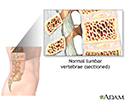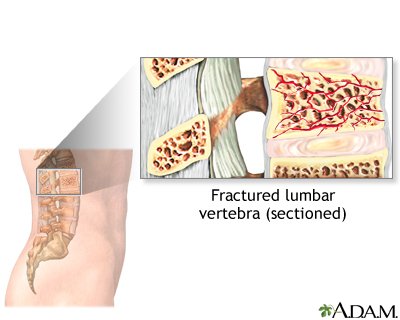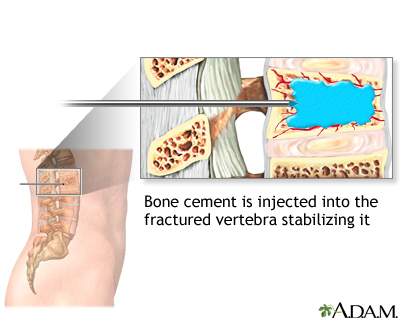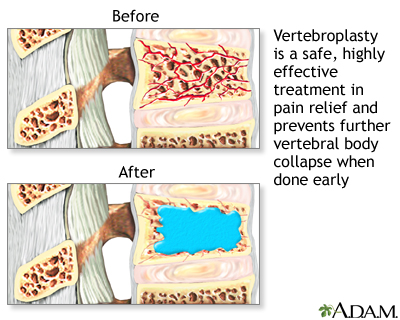Vertebroplasty
Vertebroplasty is often an outpatient procedure used to treat painful compression fractures in the spine. In a compression fracture, all or part of a spine bone collapses.
Description
Vertebroplasty is done in a hospital or outpatient clinic.
- You may have local anesthesia (awake and unable to feel pain). You will likely also receive medicine to help you relax and feel sleepy.
- You may receive general anesthesia. You will be asleep and unable to feel pain.
You lie face down on a table. The health care provider cleans the area of your back and applies medicine to numb the area.
A needle is placed through the skin and into the spine bone. Real-time x-ray images are used to guide the doctor to the correct area in your lower back.
Cement is then injected into the broken spine bone to make sure it does not collapse again.
This procedure is similar to kyphoplasty . However, kyphoplasty involves the use of a balloon that is inflated at the end of the needle to add space between the vertebrae.
Kyphoplasty
Kyphoplasty is used to treat painful compression fractures in the spine. In a compression fracture, all or part of a spine bone collapses. The proc...
Why the Procedure Is Performed
A common cause of compression fractures of the spine is thinning of your bones, or osteoporosis. Your health care provider may recommend this procedure if you have severe and disabling pain for 2 months or more that does not get better with bed rest, pain medicines, and physical therapy.
Your provider may also recommend this procedure if you have a painful compression fracture of the spine due to
- Cancer, including multiple myeloma
- Injury that caused broken bones in the spine
Risks
Vertebroplasty is generally safe. Complications may include:
- Bleeding
- Infection
- Allergic reactions to medicines
- Breathing or heart problems if you have general anesthesia
- Nerve injuries
- Leakage of the bone cement into surrounding areas (this can cause pain if it affects the spine or nerves). This problem is more common with this procedure than kyphoplasty. You may need spine surgery to correct leakage if it occurs.
Before the Procedure
Always tell your health care provider:
- If you could be pregnant
- What drugs you are taking, including those you bought without a prescription
- If you have been drinking a lot of alcohol
During the days before the surgery:
- You may be asked to stop taking aspirin, ibuprofen, coumadin (warfarin), and any other drugs that make it hard for your blood to clot several days before.
- Ask which drugs you should still take on the day of the surgery.
- If you smoke, try to stop.
On the day of the surgery:
- You will most often be told not to drink or eat anything for several hours before surgery.
- Take the drugs your provider told you to take with a small sip of water.
- You will be told when to arrive.
After the Procedure
You will probably go home on the same day of surgery. You should not drive, unless your provider says it is OK.
After the procedure:
- You should be able to walk. However, it's best to stay in bed for the first 24 hours, except to use the bathroom.
- After 24 hours, slowly return to your regular activities.
- Avoid heavy lifting and strenuous activities for at least 6 weeks.
- Apply ice to the wound area if you have pain where the needle was inserted.
Outlook (Prognosis)
Patients who have this procedure often have less pain and a better quality of life after the surgery.
They most often need fewer pain medicines, and can move better than before.
References
Anselmetti GC, Muto M, Guglielmi G, et al. Percutaneous vertebroplasty or kyphoplasty. Radiol Clin North Am . 2010;48(3):641-9. PMID: 20609898 www.ncbi.nlm.nih.gov/pubmed/20609898 .
Esses SI, McGuire R, Jenkins J, et al. The treatment of symptomatic osteoporotic spinal compression fractures. J Am Acad Orthop Surg . 2011;19(3):176-82. PMID: 21368099 www.ncbi.nlm.nih.gov/pubmed/21368099 .
Williams KD. Fractures, dislocations, and fracture-dislocations of the spine. In: Canale ST, Beaty JH, eds. Campbell's Operative Orthopaedics . 12th ed. Philadelphia, PA: Elsevier Mosby; 2013:chap 38.
Review Date: 7/13/2015
Reviewed By: C. Benjamin Ma, MD, Professor, Chief, Sports Medicine and Shoulder Service, UCSF Department of Orthopaedic Surgery, San Francisco, CA. Also reviewed by David Zieve, MD, MHA, Isla Ogilvie, PhD, and the A.D.A.M. Editorial team.





